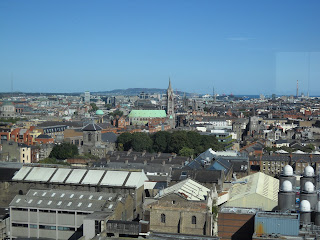Time to report on my last few days in Dublin. If you care to know the origin of the city’s name, I’ll be happy to tell you (whether you like it or not)! The Vikings built the city around 841 at the junction of the rivers Liffey and Poodle, where the combining flow of the water created a sort of black pool. The Irish word for black is Dubh and pool is Linn, and thus: Dubh Linn = Dublin. So, if the Irish had been speaking English by the time the city was built, it very well could have been named “Blackpool,” which does not sound very attractive at all (although does seem to embody the smell the city sometimes resonates).
Anyway, the highlight of Monday was the tour of the Guinness Factory Storehouse. In good old 1759, Arthur Guinness signed a nine thousand year lease to the factory for £45 a year. Since then, the brewery has grown to 64 acres (four times its original size), and has just 8,749 years left on the lease (the actual document is weirdly entombed in the factory floor):
The tour itself is seven floors and represents a giant pint glass spiraling all the way to the top. Once at the top, you’ll be able to have a pint of Guinness in a bar with glass windows that overlooks the entire city:
Now, I am not ashamed to say that I do not like beer. I think people are just plain silly for enjoying some funky alcoholic sludge water. While Guinness does taste a little better in Ireland than it does in the United States, to me it’s really the difference between drinking blended rat carcasses and drinking blended rat carcasses that have been sitting out for a few weeks (apologies to my neighbor, Mrs. Boylan). As such, the bartender was nice enough to give me a half-pint of Guinness and a half-pint of orange Fanta to wash it down with. Here’s me looking all proud with my two drinks:
Tuesday, I allowed myself to become a super-nerd and followed in the path of the 1916 Easter Rising. Let me get all historical on you. Ireland had been in a political union within the United Kingdom (along with England, Scotland, and Wales) since 1801, a fact that made Irish people grumpy over and over again. There had been many rebellions against the British (especially in the 1840s when Ireland ran out of potatoes), none of which were very successful. However, this started to change on April 24, 1916 (Easter Monday), when a pro-independence group, the Irish Republican Brotherhood, organized a rebellion while the British government was distracted by a silly thing called World War I. They stormed the post office in Dublin, made it their headquarters, and proclaimed the beginning of the Irish Republic. Here is that very post office as it stands today (I mailed some postcards from it soon after taking the picture), and a copy of the declaration of independence signed by the IRB’s leaders:
While the rebellion was initially successful, the IRB’s fortunes were short-lived. British Regiments were pulled away from the war on the Continent and starting shelling the post office from Trinity College (which, coincidentally, is right next to the hotel I was staying at). Several bullet holes are still in the columns of the post office; I was going to take a picture of some, but a Garda (policeman) was standing right there looking at me kind of weird, so I restrained myself. Anyway, on April 30, the IRB surrendered, and fourteen of its leaders were taken to the most notorious prison in Ireland: Kilmainham Gaol.
Kilmainham is now a museum where a tourguide will make you all depressed by telling you how badly Irish people were treated even less than a hundred years ago. Here's what a cell at Kilmainham looked like through its peekhole towards the end of its use in the 1920s:
Looks like my room freshman year of college! Anyway, just a week later, those fourteen Irishmen who led the Easter Rising were executed by firing squad by the British military on the crime of treason. The spot where the executions occurred is marked by a black cross in the stonebreakers’ yard:
Following the executions, the Irish populous (who initially did not support the Rising due to the violence it brought) were appalled by the tyranny and force that the British used to quell the rebellion, and more people subscribed to the belief that an independent Ireland was the better option. So though the Easter Rising failed at the time, it was the beginning of Ireland’s true struggle for independence, culminating in the Anglo-Irish Treaty of 1922, and the eventual creation of the Republic of Ireland. Without the Easter Rising, Ireland would not have been as free as it is today, and I would’ve had to think twice about studying abroad here! Oh, the humanity!
Well, that’s all I have to say about Dublin. Aw, don’t cry, kids. Maybe Dublin will make a guest appearance on a later date in this blog! As for now, I’ll be writing about Limerick once I get more situated here (possibly even in the form of a limerick). Stay tuned!








"Blackpool" certainly sounds more ominous. Give me enough Ireland material, and I will write you a poem about such a place! Or maybe my next short story, though I have a feeling it will take place behind glass and have a certain frigitity to it (like a snowglobe).
ReplyDeleteAnyway, IRELAND (the land of ire). Tell me more & more. Love the history, love the bullet-holes, the famine statues, love those crusty human details that I can pilfer for my own devious creative purposes.
Love, always!